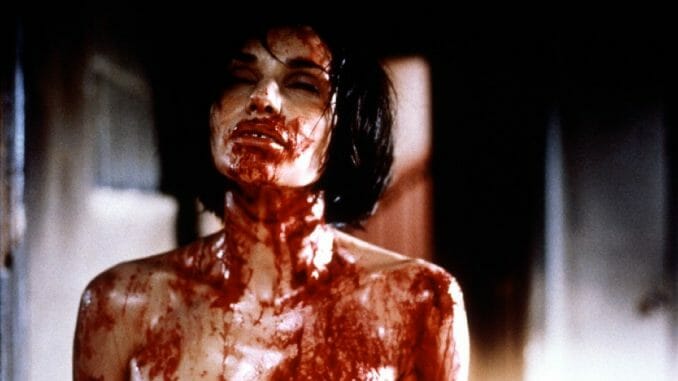Trouble Every Day’s Slow, Cerebral Cannibalism

A woman in a black negligee stands atop a hill in the dead of winter, yellow grass under her boots as she clutches an army-green coat around her skimpy frame. A man lands in Paris with his new bride, ready to celebrate their honeymoon in what’s famously lauded as the most romantic city on Earth. Upon closer inspection, streaks of dried blood surround the woman’s mouth, while the man carries anxious dread on his face unusual for a honeymooner. As it turns out, both are suffering from the same sickness: A compulsive urge to devour human beings, to gnaw on fat and tissue and imbibe hot blood. Little else moves the otherwise languorous plot of Claire Denis’ Trouble Every Day, a chilling and cerebral tale of cannibalism that follows newlywed Shane (Vincent Gallo, previously cast in Denis’ US Go Home and Nénette et Boni) and sanguine seductress Coré (the always alluring Béatrice Dalle, also appearing in Denis’ I Can’t Sleep and The Intruder) as they separately navigate their taboo desire. Shane keeps his wife in the dark as to exactly why they’re in Paris (hint: he’s trying to hunt down his fellow flesh-eater), while Coré’s husband keeps her locked in the house to prevent her from killing and devouring more hapless men.
Trouble Every Day was far from praised upon its initial release 20 years ago. Though it’s not unusual for niche arthouse horror films to find devoted fans and eventual reappraisal over time, Denis possessed the rare distinction of establishing herself as a powerhouse from the get-go, making the pan particularly painful. She was first acclaimed for her semi-autobiographical 1988 debut Chocolat, a momentum she rightfully sustained through her transcendent 1999 opus Beau Travail. Perhaps because Trouble Every Day followed immediately after, its dissenting tone of gory, ambient horror confounded critics. Amy Taubin proclaimed in The Village Voice that Trouble Every Day was “the first misstep in her career,” while others described the film as “cold and dead,” “stillborn except as a harsh conceptual exercise,” and “badly handled pretentiousness.”
That Trouble Every Day struck such a nerve is, of course, indicative of its prescient genius. The film arguably heralded the New French Extremity movement, which saw directors in the country embracing taboo and violent spectacle to push the boundaries of horror filmmaking. Although the term has come to be synonymous with films like High Tension, Inside and Martyrs, Denis’ vampiric vision of feeding via cunnilingus has undoubtedly inspired future installments in the patently putrid subgenre. Despite a community of cinephilic sickos devouring this sect of horror films much like Denis’ crazed cannibals, the categorization was first coined as a pejorative by Artforum critic James Quandt in a 2004 essay.
Citing several films that seem to transgress for the sheer satisfaction of shallow shock value, Quandt’s thorough survey begins with would-be Bresson successor Bruno Dumont’s Twentynine Palms and touches upon films by French provocateurs Gaspar Noé and Catherine Breillat, among several others. He also specifically writes about Trouble Every Day, complaining about the film’s apparent lack of narrative and Denis’ illogical distancing from her previous fascination with France’s colonial ties and enduring racism. He brands the then-newfound cinematic movement as “an aggressiveness that is really a grandiose form of passivity.”
-

-

-

-

-

-

-

-

-

-

-

-

-

-

-

-

-

-

-

-

-

-

-

-

-

-

-

-

-

-

-

-

-

-

-

-

-

-

-

-








































